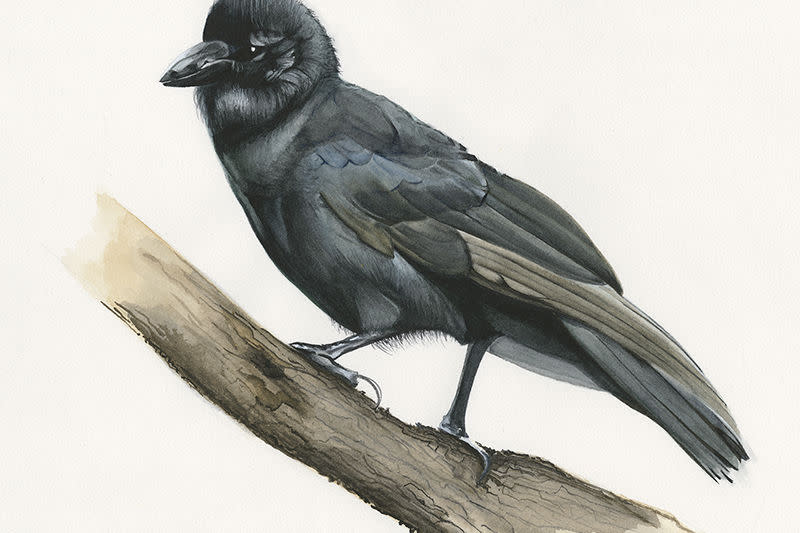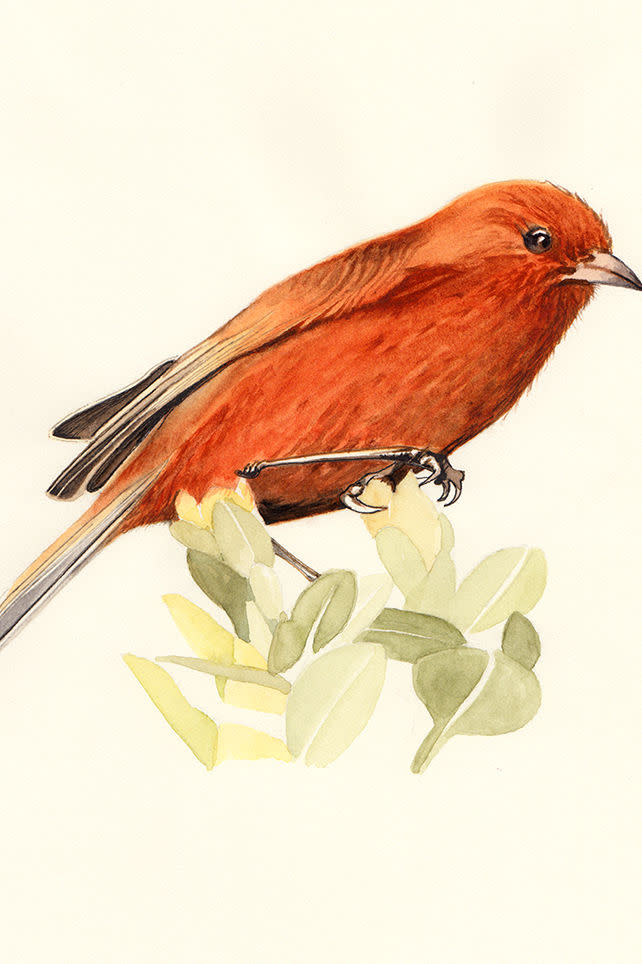Building the Hawaiian Dream House: Island Birds
This column’s for the birds.
When humans arrived to the Hawaiian Islands, there were more than 140 species of native birds. Today, more than half of them are extinct. There’s no other place in the United States where avian extinction has been so extreme, and even now two-thirds of Hawaii’s forest birds are endangered.

But I intend this as a hopeful story. In Hawaiian mythology, some animals are considered ‘aum?kua, or guardian spirits. The pueo, an endemic short-eared owl we spotted peering up at us after our land blessing, is one of them. Another is the Hawaiian crow, better known locally as the ?alal?. Endangered since 1967, this crow is one of just 69 species across the planet that has been classified as extinct in the wild (the others are mostly plants and tree snails). Before human colonization, the ?alal? was one of five crow species on the Big Island, and once it was one of the largest bird populations anywhere in the state. And today? Today, it’s one of the four most-endangered bird species on earth, the result of loss of habitat, introduced disease, and predation by introduced rats, mongooses, dogs and feral cats. When its numbers were healthy, the ?alal? played a crucial role in seed dispersal and seed germination of native plants. Before Europeans arrived, it was sometimes kept as a ceremonial pet and its feathers were used to decorate royal standards known as kahili. Measuring up top 20 inches, with a 42-inch wingspan, it’s the state’s second-largest forest bird after the once-endangered Hawaiian hawk, which is also an ‘aum?kua. If healthy and undisturbed, the ?alal? can live up to 18 years in the wild.
So here’s the hopeful part of this story: 114 ?alal? are being raised in captivity on the Big Island and Maui, for reintroduction into two of Big Island’s forests later this year, including the Pu’u Maka’ala Natural Area Reserve, an 18,730-acre conservation area established in 1981 to protect the island’s native wet koa and ohia forests—and a component of a larger system covering 95,000 acres on the Big Island and 123,000 acres statewide. The ?alal?’s release is part of a five-year recovery plan by the U.S. Fish and Wildlife Service, the State of Hawaii’s Division of Forestry and Wildlife, and the San Diego Zoo’s Global Institute for Conservation Research, which three weeks ago announced it had also sequenced the ?alal?’s genome. The estimated cost of saving this creature from extinction: $14.38 million. An earlier attempt to release the ?alal? in the mid-90s failed, so this is truly a second chance.

Later this year, in September, Hawaii will also host the World Conservation Congress, which the International Union for Conservation convenes every four years. (Sometimes regarded as the “conservation world Olympics,” the last two were in Jeju Island, South Korea, and in Barcelona.) With nearly 1,300 government and NGO members, and more than 15,000 volunteer experts from 185 countries, the Switzerland-based IUCN is the largest and oldest global environmental organization in the world, and its Red List tracks threatened, vulnerable and endangered species around the globe. The IUCN even has official observer status at the United Nations. The U.S. State Department lobbied the IUCN to host the congress in Hawaii, and holding it there is an international vote of confidence for what’s being done by Hawaii and the U.S. Keeping our eyes to the trees, the U.S. Fish and Wildlife Service is behind a separate 50-year, $3.63-billion effort to recover another 21 endangered Hawaiian forest birds throughout the state. If you find yourself in Hawaii, consider going on a bird-watching tour with Hawaii Forest & Trail, which has been leading them there since 1994. But you might want to bone up with these recordings of the ?alal?’s calls first.

Paula made the three paintings in this post. I introduced her in my first blog as a botanical illustrator, textile designer, horticulturist and writer. But like John James Audubon (who was born and raised outside the United States, in what later became Haiti, and in France), she’s now officially an ornithological painter, too. You can see larger versions of these works on her site. The second and third paintings are of the ?akiap?l??au and ?akepa, both endangered Hawaiian honeycreepers.
I grew up visiting the New-York Historical Society’s Audubon collection on the Upper West Side of Manhattan, and I’m looking forward to hanging these paintings in our house on the Upper North Side of Hawaii (a.k.a. North Kohala) once it is ready. I’m tempted to say I hope birds stay away from our most recent construction, but if they’re ?alal? then they can come.


Watch the dream house construction unfold from the beginning:



